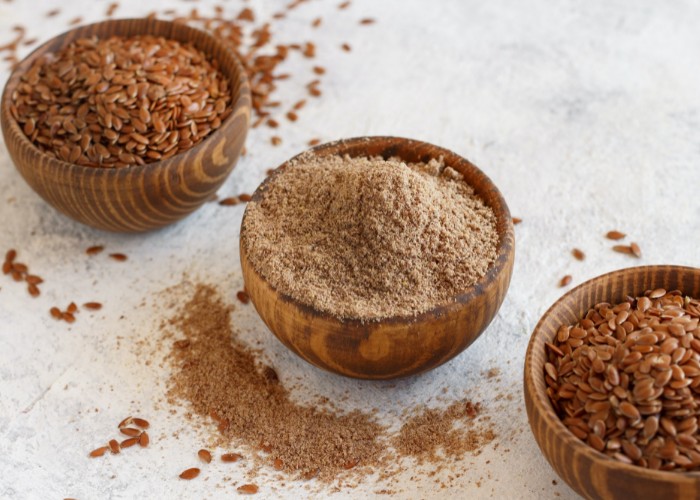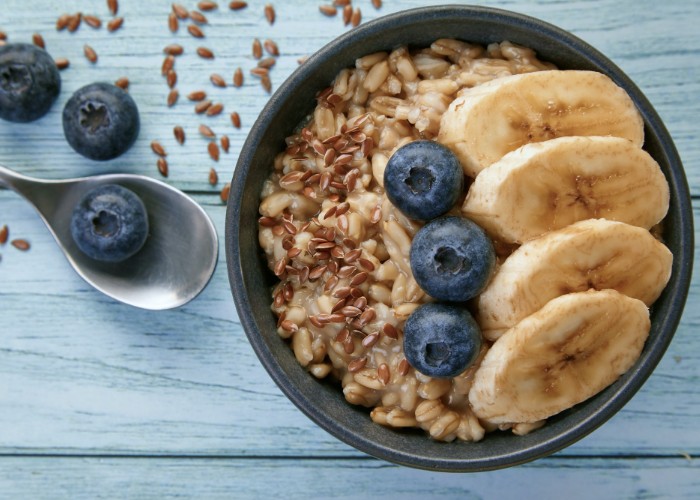Benefits of eating flaxseed and how to add it into your diet
If you want to know why these shiny little seeds you should incorporate into your diet you are at the right place!
Flaxseed is called also a “functional food” which means that a person can eat it to boost their health, which now is popular all around the world is super rich in omega-3s, fiber, protein, antioxidants, and other compounds that are very important for people’s health.
According to many studies flaxseed is linked to many health benefits, from improving digestion, better heart health, type 2 diabetes and so much more.
Here in this article, you will find out everything you need to know about flaxseed: the benefits of incorporating these edible seeds into your diet, how to use them, possible side effects of eating too much flaxseed and so much more.
This post may contain affiliate links, which means we may receive a small commission, at no cost to you, if you make a purchase through a link. For more information, please see our disclosure.
What is flaxseed?
Flaxseed, also known as linseed comes from the flax plant (Linum usitatissimum) which was firstly grown in Egypt but now is cultivated around the world.

We also must mention that every part of the flax plant has its use. Flax seeds are used also for making linseed oil, woodworking, and carpentry. Flax fibers are used to make linen and rope.
Primarily when this plant first came to North America, it was grown to produce clothing. The flax plant can be woven into linen, which fibers are two to three times as strong as cotton!
In the mid 20th century cotton took over as the U.S. fiber of choice, so today most places in North America that grow flax do so to produce edible seeds.
In North America, flaxseed is the preferred term for flax used for human consumption, while Europeans use the term linseed for edible flax.
Currently, it is cultivated in more than 50 countries, predominantly in the Northern hemisphere. Canada is the world’s largest producer and exporter of flaxseed.
Types of flax seeds
There are two basic types of flaxseed, golden and brown.
The dark brown seeds have a somewhat stronger flavor than golden ones. Maybe the only difference between these two types except the color is the alpha-linolenic acid content. The dark seeds are slightly higher in ALA than the golden variety.
Taste profile – Flax seeds have a slightly mild, nutty flavor and can be eaten on their own or crushed and cold-pressed to release flaxseed oil.
These edible seeds are ideal for adding to both savory and sweet foods, children and picky eaters may not notice a little flaxseed meal when it’s added to their favorite foods in small amounts.
For decades these edible seeds were used in things like bread or cereals, but today people have become knowledgeable about flaxseed health benefits and now have many ways to get their fill, whether as a supplement or as an ingredient they add to a variety of foods.
Flaxseed benefits
Today these tiny, small, edible seeds have gained “superfood” status because more scientific research points to their health benefits.
Flaxseed is establishing importance in the world’s food chain as a functional food.
Functional food is defined as food or food ingredients that may provide physiological benefits and helps in preventing and/or curing diseases.
Flaxseed as a functional food
Flaxseed is considered a functional food owing to the presence of three main bioactive components: lignans, alpha-linolenic acid, and dietary fiber.
Here is a list of the main health benefits of eating flaxseed and why these compounds present in flaxseed are so important for your health:
Loaded with nutrients
A typical serving size for ground flax seeds is 7 grams or 1 tablespoon. In just one tablespoon of flaxseed, there is a good amount of fiber, omega-3 fatty acids, and protein. Also, this edible seed is a rich source of vitamins and minerals like thiamine (B1), copper, molybdenum, magnesium, and phosphorus.
They consist of 42% fat, 29% carbs, and 18% protein.
According to USDA one tablespoon (7 grams) of ground flax seeds contains the following:
- Calories: 37
- Protein: 1.28 grams
- Carbs: 2.02 grams
- Fiber: 1.91 grams
- Total lipid (fat): 2.95 grams
- Omega-3 fatty acids: 1,597 mg
- Vitamin B1: 8% of the RDI
- Magnesium: 7% of the RDI
- Phosphorus: 4% of the RDI
If you are on a low-carb diet, flax seeds and flaxseed oil are highly recommended for their low carb properties and the high quantities of essential fatty acids.
Flaxseed is a great source of lignans and may help lower cancer risk
Flaxseed is rich in lignans. Lignans are plant compounds that have estrogen and antioxidant properties. These plant compounds are thought to have antiangiogenic properties, which means they may stop tumors from forming new blood vessels and growing.
A study from 2013 showed that involved more than 6,000 women, found that those who regularly consumed flaxseed were 18% less likely to develop breast cancer.
Also, studies show that eating flaxseed is also good for men too. In a pilot study that included 15 men, those given 30 grams of flax seeds a day while following a low-fat diet showed reduced levels of a prostate cancer marker, which suggests a lower risk of prostate cancer.
Good To Know
Flaxseed contains about 75-800 times more lignans than legumes, cereal grains, fruits, and vegetables.
High in omega-3 fats
Flaxseed contains 42% fat and this fat content is composed of:
- 73% polyunsaturated fatty acids, such as omega-6 fatty acids and the omega-3 fatty acid alpha-linolenic acid (ALA)
- 27% monounsaturated and saturated fatty acids
It is rich in both essential fatty acids – alpha-linolenic acid (ALA) and linolenic acid (LA). Fatty acids are termed as essential because both are required by the body but the body can’t synthesize them, therefore need to be supplied in the diet.
Flaxseed is one of the richest sources of ALA and only chia seeds contain more ALA.
A review from 2012 that involved 27 studies and over 250,000 people found that ALA was linked to a 14% lower risk of heart disease. Also, a Costa Rica study found that those who ate more ALA had a lower risk of heart attack than those who consumed less ALA.
Flaxseed oil contains the highest amount of ALA, followed by milled seeds. Eating the whole seeds provides the least amount of ALA, as the oil is locked up inside the fibrous structure of the seed.
Flaxseed and omega-3s
Flaxseed is the best source of omega-3 fatty acids, especially if you don’t eat fish or you are a vegetarian.
Rich in dietary fiber
Flaxseed contains two types of dietary fiber: soluble and insoluble.
- 20-40% of soluble fiber (mucilage gums)
- 60-80% of insoluble fiber (cellulose and lignin)
Just one tablespoon of flax seeds contains 3 grams of fiber, and this is equal to 8-12% of the daily recommended intake for men and women, respectively.
Why dietary fiber is so important for your health? – The soluble fiber increases the consistency of the contents of your intestine and slows down your digestion rate. This helps to regulate blood sugar and lower cholesterol.
On the other hand, insoluble fiber allows more water to bind to the stools, increases their bulk, and results in softer stools. This helps to prevent constipation and for those who have irritable bowel syndrome and diverticular disease.
Flaxseed and fiber content
Adding flax seeds to your diet promotes regular bowel movements, prevents constipation, and reduces your risk of diabetes.
Great source of high-quality protein
Another benefit of eating flax seeds is that they are a great source of plant-based protein which is rich in amino acids arginine, aspartic, and glutamic acid.
If you plan to cut back on meat and looking for a protein alternative then flaxseed may just be your answer.
This is backed by science too. In a study from 2015, 21 adults were given an animal protein meal or plant protein meal. The results from the study showed that there was no difference in terms of appetite, satiety or food intake noted between the two meals.
It’s likely both the plant and animal protein meals stimulated hormones in the gut to bring about the feeling of fullness, which resulted in eating less at the next meal.
Flaxseed may be helpful for weight control
Flaxseed dietary fiber content may aid weight control by suppressing hunger and increasing feelings of fulness.
Most of the soluble fiber in flaxseeds is called mucilage. The fiber combines with water to form a gel-like consistency that slows the emptying of the stomach. This leads to increased feelings of fullness and delays the return of hunger.
A meta-analysis of 45 studies concluded that the consumption of 30 grams of flaxseed a day or about two tablespoons resulted in reductions in body weight and waist measurement.
If you want to find how effective are flax seeds for weight loss, here is an article for you: Chia Seeds vs. Flax Seeds: Which Is Better For Weight Loss?
Flaxseed might curb diabetes risk
Taking flaxseed might improve blood sugar control in people with type 2 diabetes. benefits of flaxseed seem to be greatest with whole flaxseed and when used for at least 12 weeks.
In a small study, scientists gave people 0g, 13g, or 26g of flaxseed daily for 12 weeks. The people in the group who consumed 13g of flaxseed a day had lower blood glucose and insulin levels, and improved insulin sensitivity at the end of the study period.
May improve skin hydration and smoothness
One small study about the effects of flaxseed oil and skin sensitivity showed that giving women flaxseed oil led to a significant decrease in skin sensitivity, and reduced skin roughness, and scaling, all while improving skin hydration and smoothness.
How to reap the maximum of the flaxseed benefits
Ground or whole flaxseed? What to choose to get all the benefits from flaxseed? – Most nutrition experts recommend ground over whole flaxseed because the ground form is easier to digest.
That’s because whole flaxseed is likely to pass through your intestine undigested and the healthful fats and other nutrients won’t be absorbed into your bloodstream.
Good To Know
The oils in flax are delicate and can begin to break down when exposed to light or air. To take full advantage of their perks grind the seeds up in a coffee grinder right before you eat them.
Possible side effects of eating too much flaxseed
Flaxseed is likely safe for most adults when taken by mouth appropriately. Adding too much flaxseed into your diet might increase the number of bowel movements each day. It may also cause side effects like bloating, gas, constipation, diarrhea.
There is some concern that taking a large amount of flaxseed could block the intestines due to the bulk-forming laxative effects of flaxseed. So, flaxseed should be taken with plenty of water to prevent this from happening.
Risks during pregnancy
Studies on this subject are limited, but many health professionals fear that consuming flaxseed during pregnancy may have undesirable effects.
This is due to the phytoestrogens in the seeds which may act as similar to the female hormone estrogen. Smaller doses of flaxseed are safe to consume, but during pregnancy and breastfeeding, it’s recommended to limit your intake of flax seeds and other sources of phytoestrogens.
Cyanogenic glycosides
Flax seeds contain plant compounds called cyanogenic glycosides. These substances bind with sulfur compounds in your body thiocyanates. An excessive amount of thiocyanates may have a negative effect on your thyroid gland.
Those with thyroid problems should avoid high amounts of flaxseed. Moderate portions won’t cause any side effects in healthy individuals.
Phytic acid
People who are deficient in iron or follow an imbalanced diet should be aware that flaxseed contains phytic acid.
Phytic acid is often referred to as an antinutrient – it may reduce the absorption of minerals like iron and zinc. Still, phytic acid doesn’t cause any lasting reduction in mineral absorption and doesn’t affect any subsequent meals.
Blood-thinning effects
If you are taking blood thinners or other medications consult with your health professional before consuming larger amounts of flaxseed.
What is the safe dosage of flax seeds?
To reap the health benefits of flaxseed it is recommended to consume 1-2 tablespoons of ground flax seeds or 1 tablespoon of flaxseed oil.
Due to the presence of fiber and fat content if you eat large servings of flaxseed you may experience excess gas and bloat.
If you are taking flaxseed for constipation consume 2 tablespoons daily, toddlers should consume about 1 tablespoon per day.
It is recommended to keep serving sizes to less than 5 tablespoons or 50 grams of flax seeds per day.
Don’t forget to drink enough water at least 2-4 liters a day, to prevent the side effects of these edible seeds.
How to incorporate flaxseed into your diet?
There are many ways to add a daily dose of flaxseed to your meal and the best part is you don’t need to reconstruct your food habits or change your daily diet.

Here is how you can add flaxseed into your diet and reap all the benefits from these healthy edible seeds:
Egg substitute
You can replace eggs in a recipe using ground flaxseed. To do this use one tablespoon of flax seeds and three tablespoons of water, combined, to replace one egg.
Smoothies
One or two tablespoons of ground flaxseed can be added to your morning smoothie with greens, berries and the best part is that the seeds become blended into all other fruits and become unrecognizable, leaving you with a heart-healthy start to the day.
Topped on oatmeal
Flaxseed is a great addition to a bowl of oatmeal for breakfast. Ground flaxseeds stir in well with unrefined, unprocessed oats.
Baking
Ground flaxseed makes a healthy, fiber, and protein-filled addition to baked goods. You can replace 25 to 50 percent of the flour in your favorite muffin or bread recipes with flax meal. But remember the flax lacks gluten, the protein in wheat that gives the baked goods their light, chewy texture. So adding too much flax meal to a recipe will make your product heavier and denser.
Added to granola
Making homemade granola is a cheaper, healthier alternative to store-bought granola. Including whole flax seeds in the granola adds fiber to the granola.
Sprinkled on salads
Try roasting the whole or ground flaxseeds by placing them in a skillet over medium heat and letting them sit for five minutes. If you don’t like croutons on your salad, try adding some flax seeds.
Using flaxseed flour
Flaxseeds are milled and sold in the form of flour. You can make flax flour at home by simply grinding up whole flaxseeds to a fine powder. Flax flour can be used in a direct 1:1 ratio with white and wheat flour, or they can be used together. When used in baking recipes it tends to make food chewier and flatter, and it’s also a great gluten-free alternative to regular flour.
To find out more on how to eat flaxseed and what are the best ways to incorporate it into your diet read this article: Best Ways To Eat Flax Seeds Without Changing Your Diet.
Flaxseed oil: What is it and why it’s good for you?
Flaxseed oil is made from ground and pressed flax seeds. It is also known as flax oil or linseed oil.
One of the best things about this oil is that it can easily be swapped for other types of oil in salad dressings, dips, and sauces.
Also, flaxseed oil can be applied to the skin or added to your favorite skin cream to increase moisture in the skin and improve skin health. It can also be applied to hair to promote shine and growth.
If you can’t find flaxseed oil at your grocery store, it is available to buy it online and we recommended this Cold-Pressed Organic Flaxseed Oil.
Flaxseed oil and cooking
Flaxseed oil should not be used for cooking, recipes that require heating, such as stir-fries or baking. When exposed to heat, the oil can form harmful chemicals.
Where to buy and how to store flaxseeds
Flax comes in several forms, and you must know some things before start using these super healthy edible seeds:
Whole flaxseed has the longest shelf life, but you must grind it in a food processor coffee grinder before using it. Otherwise, it is hard for your body to break down whole flaxseed and you won’t get anything of all those nutrients. You can buy whole flaxseed online, here is our recommendation Whole Organic Flaxseed with a nutty taste.
Pre-ground or milled flaxseed has a shorter shelf life than whole seeds. Buy as much as you can use before they expire, always check the expiration date. You can store it in the fridge to ward of spoiling (flax becomes rancid, it will have a sour smell and bitter taste). Try this Organic Ground Flaxseed, that adds a pleasant nutty flavor to foods while boosting everyday nutrition. Great for cereals, desserts, smoothies, and more.
You can keep whole flax seeds at room temperature for up to a year, but once they are ground, the flaxseed meal should be used as soon as possible.

Final thoughts about the benefits of flaxseed, possible side effects, and uses
The benefits of flaxseed are confirmed by many studies and the high content of omega-3 fatty acids, fiber, lignans, and other plant compounds are responsible for many of the seed’s benefits.
No matter what will you choose ground or whole, flax seeds are easy to add to any of your favorite foods. You can use them in smoothies, salads, oatmeal, for baking. as an egg substitute and so much more.
These tiny powerhouses, flax seeds are so popular today and there is no better time than now to start incorporating them into your diet.




